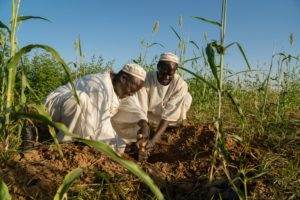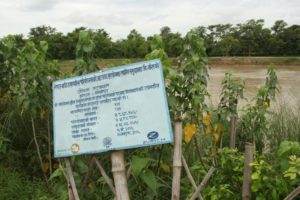Nature-Based Solutions: Harnessing Nature for People and the Planet
Nature-based solutions are one of the themes at the forefront of this year’s UN Climate Change Conference (COP26). If done well, nature-based solutions can protect, sustainably manage, and restore ecosystems. At the same time, they can address societal challenges such as climate change, biodiversity loss, and poverty and inequality.
In this introduction to the topic, we’ll explore what nature-based solutions are and why they’re so important, particularly in the context of COP26. We’ll also take a closer look at some examples of successful nature-based solutions from Practical Action’s work around the world.
What are nature-based solutions?
In short, nature-based solutions are interventions that protect, restore or sustainably manage nature.
A longer and more comprehensive description is given by the International Union for Conservation of Nature:
“Actions to protect, sustainably manage, and restore natural or modified ecosystems, that address societal challenges effectively and adaptively, simultaneously providing human well-being and biodiversity benefits”.
More generally, ‘nature-based solutions’ is a broad term that can be used to describe non-traditional, alternative or indigenous approaches to environmental issues, like flooding, drought, or soil degradation, by harnessing natural resources.
Nature-based solutions are an alternative to the traditional method of infrastructure development. Sometimes described as ‘gray’, these often involve constructed and artificial structures. In contrast, nature-based solutions encompass natural, green, and integrated structures.
Why are nature-based solutions so important right now?
Governments and businesses are getting increasingly interested in nature-based solutions because they offer the possibility of tackling huge issues like climate change and poverty in a cost-effective way.
However, for nature-based solutions to be beneficial, they also must be good for people. In particular, they must work for marginalised and indigenous people and local communities.
That’s why it is so important that evidence like our own work in Sudan, Nepal and around the world is available to decision-makers and planners.
We’ll be attending the UN negotiations as an official observer for the 6th consecutive year. This will enable us to influence the discussions, support negotiators from developing countries, challenge the level of ambition, and encourage international cooperation and collaboration.
We’ll be calling for agreement on specific targets and commitments in a number of areas. One of these is nature-based solutions. We want to see nature-based solutions included within all climate plans at an ambitious level to protect remaining primary ecosystems, and restore degraded land including forests and wetlands.
Nature-based solutions are an integral part of many of our projects with communities around the world. In Sudan, they are turning deserts green, while in Nepal they are protecting communities from floods…
Community-based land and water management in Sudan
In North Darfur in Sudan, rainfall has become less reliable due to climate change. Farmers don’t have enough water to irrigate their crops properly or to give to their animals. Whole communities have abandoned their homes after losing their farmland to desertification.
Our climate-based adaption work involves 35,600 people from 19 villages over a three-year period, aiming to improve conditions and address some of the threats posed by climate change. Water management, forest planting, re-greening and farming and business training are all part of a solution that will help communities in Sudan thrive, even in one of the world’s toughest places to farm.
Our integrated water resource management is helping communities restore the land in and beyond low-lying, fertile wadis (natural water sources). Earth dams and crescent terraces are constructed to reduce runoff, increase infiltration and prevent gully formation.
As part of rangeland rehabilitation, good-quality indigenous grass seeds are planted. We also supported communities to plant trees to restore communal forested areas and sustainably manage rangelands.

Re-greening helps barren areas of Sudan come back to life
As a result of this work, underground water sources have been replenished, forests have been restored and farmland is fertile once again. Food security has improved and conflict between farmers and pastoralists has reduced.
“Planting forests to re-green land lost to the changing climate is one of the ways we use the saved water. These trees put vital nutrients back into the soil, making it more fertile. Their roots also improve the stability of the soil, which decreases the damage caused by floods during the rainy season. This work, along with the extra water available for irrigation, helps make farming more viable on more land that was previously barren.”
Awadalla Hamid Mohamed, Practical Action project manager in Sudan
Our water management work in Sudan was recently featured in a report by Bond: Nature-based Solutions in Action: Lessons from the Frontline (Harnessing nature to address the triple emergency of poverty, climate change and biodiversity loss).
Natural solutions for flood protection in Nepal
In Nepal, climate change has caused monsoon flooding to become increasingly severe and unpredictable. People’s crops, property and businesses are destroyed by floods every year.
Bio-dykes are an environmentally-friendly alternative to normal flood defences, where ‘normal’ means huge concrete structures that are expensive to build, damage the environment and are catastrophic when they fail.
We’ve worked with communities on the Karnali river in Nepal to build bio-dykes by strategically planting locally-available trees and other plants. The bio-dykes bind the soil and help prevent erosion, maintaining the original flow of the river, while also preventing the river from overflowing after heavy rainfall.

The 220m-long bio-dyke on the Karnali River in Nepal was built by the local community with our support, using natural, locally-available materials. It’s protecting the property, possessions and crops of 135 households from flooding.
Bio-dykes deliver economic, environmental and social benefits. They really are a win, win, win solution – unlocking the triple dividend of resilience in terms of saving lives and avoiding losses when disasters strike, stimulating local economic activity, and delivering additional development co-benefits. Bio-dykes have been instrumental in protecting communities’ homes, agricultural land and public infrastructure, reversing the annual cycle of flood losses and increasing the confidence of communities to invest in long term land and farm productivity.
“The river used to erode 4-5 metres of land every year. Two people from each household worked for 25 days to build this bio-dyke. This year there has been no soil erosion at all.”
Phularam Chaudhary, local flood resilience committee chair
This innovative use of bio-dykes has been recognised by the government of Nepal, who have prioritised bio-dykes and other nature–based solutions in their annual national budget for flood protection.
Our flood protection work in Nepal is one of three natural solutions being used to develop a new methodology to help make the case for nature-based solutions and take them to scale.
The methodology, created in partnership with the Zurich Flood Resilience Alliance, provides a framework by which communities can assess the financial, social and environmental costs and benefits for themselves – providing a robust, real-world business case with which to attract government, donors, community organizations, and NGO partners.
What’s next?
COP26 will be biggest summit ever hosted in the UK, with around 30,000 attendees expected in November 2021. It’s been described by climate change experts as the most significant climate event since the 2015 Paris Agreement. That’s because COP26 is the first moment when countries must report back on their progress since the Paris Agreement and set out more ambitious goals for ending their contribution to climate change.
One of our major roles is to balance things out by making sure voices from the Global South are heard. Our team will be on hand to listen to the negotiations and to help delegates from less developed nations provide research, evidence, examples and testimony to show the impact of climate change on their populations and the value of nature-based solutions.
Follow our journey to COP26 and beyond on LinkedIn and Twitter. You’ll also learn more about our work around the world, helping people living on the front line of the climate crisis adapt and succeed.